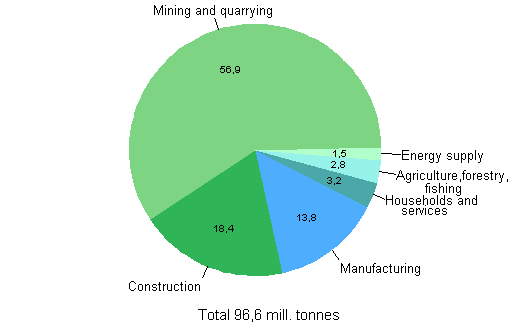Published: 17 May 2013
Changes in waste treatment
Waste treatment is going through a powerful period of change. In 2011, 22 per cent more waste was incinerated than in the year before, amounting to over ten million tonnes. Wood residue of manufacturing and other production and municipal waste were used to produce over ten per cent of total energy consumption and over one fifth if black liquor from the forest industry is included. Waste was also recycled more than one year previously. The amount of recycled waste rose by 18 per cent, to nearly 34 million tonnes. In contrast, 19 per cent less waste was placed at landfill sites or long-term deposits than in the year before.
Amounts of waste by sector in 2011, million tonnes

Treatment of construction waste diversified
Over 1.7 million tonnes of waste generated in construction was utilised or transported to pre-processing for utilisation in 2011. In addition to sorting of metal parts, combustible waste and mineral constituents generated in repair, demolition and newbuilding are sorted and utilised more effectively than before. Concrete and other crushed mineral waste is used for foundation structures of public roads and fields, for example. In 2011, mineral waste used or treated for utilisation amounted to 1.3 million tonnes and metal waste to 100,000 tonnes. Energy production used 250,000 tonnes of wood waste from construction. Around 250,000 tonnes of construction waste ended up at landfill sites. In 2011, the total amount of construction waste was 2.2 million tonnes. The figures do not include soil waste or dredging spoils generated in construction.
Waste from production and consumption totalled 96 million tonnes in 2011
Among all industries, mining and quarrying was still the biggest producer of waste. The amount of waste generated there rose to over 56 million tonnes in 2011 and was record high. Manufacturing produced 13.8 million tonnes of waste. The amount of waste produced by manufacturing varies more than in other industries according to the cycles of the national economy and is significantly determined by the output volumes of the forestry, metal and chemical industries. Energy production generated its customary 1.5 million tonnes of waste, mainly ash; households and services 3.2 million tonnes, mostly municipal waste; and agriculture and forestry 2.7 million tonnes, primarily logging waste residue.
Source: Waste statistics 2011, Statistics Finland
Inquiries: Juha Espo 09 1734 3463, Jukka Muukkonen 09 1734 3224, ymparisto.energia@stat.fi
Director in charge: Leena Storgårds
Publication in pdf-format (238.3 kB)
- Tables
-
Tables in databases
Pick the data you need into tables, view the data as graphs, or download the data for your use.
Appendix tables
Updated 17.5.2013
Official Statistics of Finland (OSF):
Waste statistics [e-publication].
ISSN=2323-5314. 2011. Helsinki: Statistics Finland [referred: 19.4.2025].
Access method: http://stat.fi/til/jate/2011/jate_2011_2013-05-17_tie_001_en.html

